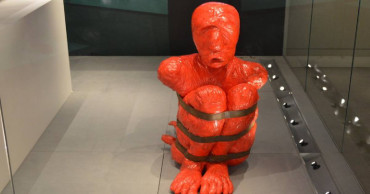slave trade
Dutch leader apologizes for Netherlands' role in slave trade
Dutch Prime Minister Mark Rutte apologized Monday on behalf of his government for the Netherlands’ role in slavery and the slave trade, in a speech welcomed by activists as historic but lacking in concrete plans for repair and reparations.
“Today I apologize,” Rutte said in a 20-minute speech that was greeted with silence by an invited audience at the National Archive.
Ahead of the speech, Waldo Koendjbiharie, a retiree who was born in Suriname but lived for years in the Netherlands, said an apology was not enough.
Read more: Seoul court rejects Koreans claim for compensation from Japanese companies for slave labor during colonial occupation
“It’s about money. Apologies are words and with those words you can’t buy anything,” he said.
Rutte told reporters after the speech that the government is not offering compensation to “people — grandchildren or great grandchildren of enslaved people.”
Instead, it is establishing a 200 million-euro ($212 million) fund for initiatives to help tackle the legacy of slavery in the Netherlands and its former colonies and to boost education about the issue.
Rutte apologized “for the actions of the Dutch state in the past: posthumously to all enslaved people worldwide who have suffered from those actions, to their daughters and sons, and to all their descendants into the here and now.”
Describing how more than 600,000 African men, women and children were shipped, "like cattle" mostly to the former colony of Suriname, by Dutch slave traders, Rutte said that history often is “ugly, painful, and even downright shameful.”
Rutte went ahead with the apology even though some activist groups in the Netherlands and its former colonies had urged him to wait until July 1 of next year, the anniversary of the abolition of slavery 160 years ago and said they had not been sufficiently consulted in the process leading up to the speech. Activists consider next year the 150th anniversary because many enslaved people were forced to continue working in plantations for a decade after abolition.
Read more: California task force launches study of slave reparations
Mitchell Esajas, director of an organization called The Black Archives and a member of activist group Black Manifest, did not attend the speech despite being invited because of what he called the “almost insulting” lack of consultations with the Black community.
He said it was a historic moment but lamented the lack of a concrete plan for reparations.
“Reparation wasn’t even mentioned," Esajas said. "So, beautiful words, but it’s not clear what the next concrete steps will be.”
Rutte's gave his speech at a time when many nations' brutal colonial histories have received critical scrutiny because of the Black Lives Matter movement and the police killing of George Floyd, a Black man, in the U.S. city of Minneapolis on May 25, 2020.
The prime minister's address was a response to a report published last year by a government-appointed advisory board. Its recommendations included the government's apology and recognition that the slave trade and slavery from the 17th century until abolition "that happened directly or indirectly under Dutch authority were crimes against humanity.”
The report said that what it called institutional racism in the Netherlands “cannot be seen separately from centuries of slavery and colonialism and the ideas that have arisen in this context.”
Dutch ministers fanned out Monday to discuss the issue in Suriname and former colonies that make up the Kingdom of the Netherlands — Aruba, Curacao and Sint Maarten as well as three Caribbean islands that are officially special municipalities in the Netherlands, Bonaire, Sint Eustatius and Saba.
In Suriname, , the small South American nation where Dutch plantation owners generated huge profits through the use of enslaved labor, the largest opposition party, NDP, condemned the Dutch government for failing to adequately consult descendants of enslaved people in the country. Activists in the country say that what's really needed is compensation.
“The NDP therefore expresses its disapproval of this unilateral decision-making process and notes that the Netherlands is comfortably taking on the role of the mother country again," the party said in a statement.
The year starting July 1, 2023, will be a slavery memorial year in which the Netherlands “will pause to reflect on this painful history. And on how this history still plays a negative role in the lives of many today,” the government says.
The Dutch first became involved in the trans-Atlantic slave trade in the late 1500s and became a major trader in the mid-1600s. Eventually, the Dutch West India Company became the largest trans-Atlantic slave trader, said Karwan Fatah-Black, an expert in Dutch colonial history and an assistant professor at Leiden University.
In 2018, Denmark apologized to Ghana, which it colonized from the mid-17th century to the mid-19th century. In June, King Philippe of Belgium expressed “deepest regrets” for abuses in Congo. In 1992, Pope John Paul II apologized for the church’s role in slavery. Americans have had emotionally charged fights over taking down statues of slaveholders in the South.
Now the Netherlands has joined their ranks.
But for some in the Black community, the notable day was tinged with disappointment.
“For a lot of people, it’s a very beautiful and historic moment but with — in Dutch we say — a bitter taste ... and it should have been a historic moment with a sweet taste,” Esajas said.
3 years ago
Ancient coins may solve mystery of murderous 1600s pirate
A handful of coins unearthed from a pick-your-own-fruit orchard in rural Rhode Island and other random corners of New England may help solve one of the planet’s oldest cold cases.
The villain in this tale: a murderous English pirate who became the world’s most-wanted criminal after plundering a ship carrying Muslim pilgrims home to India from Mecca, then eluded capture by posing as a slave trader.
“It’s a new history of a nearly perfect crime,” said Jim Bailey, an amateur historian and metal detectorist who found the first intact 17th-century Arabian coin in a meadow in Middletown.
That ancient pocket change — among the oldest ever found in North America — could explain how pirate Capt. Henry Every vanished into the wind.
Also read: Ancient Greek god's bust found during sewage work
On Sept. 7, 1695, the pirate ship Fancy, commanded by Every, ambushed and captured the Ganj-i-Sawai, a royal vessel owned by Indian emperor Aurangzeb, then one of the world’s most powerful men. Aboard were not only the worshipers returning from their pilgrimage, but tens of millions of dollars’ worth of gold and silver.
What followed was one of the most lucrative and heinous robberies of all time.
Historical accounts say his band tortured and killed the men aboard the Indian ship and raped the women before escaping to the Bahamas, a haven for pirates. But word quickly spread of their crimes, and English King William III — under enormous pressure from a scandalized India and the East India Company trading giant — put a large bounty on their heads.
“If you Google ‘first worldwide manhunt,’ it comes up as Every,” Bailey said. “Everybody was looking for these guys.”
Until now, historians only knew that Every eventually sailed to Ireland in 1696, where the trail went cold. But Bailey says the coins he and others have found are evidence the notorious pirate first made his way to the American colonies, where he and his crew used the plunder for day-to-day expenses while on the run.
The first complete coin surfaced in 2014 at Sweet Berry Farm in Middletown, a spot that had piqued Bailey’s curiosity two years earlier after he found old colonial coins, an 18th-century shoe buckle and some musket balls.
Waving a metal detector over the soil, he got a signal, dug down and hit literal paydirt: a darkened, dime-sized silver coin he initially assumed was either Spanish or money minted by the Massachusetts Bay Colony.
Peering closer, the Arabic text on the coin got his pulse racing. “I thought, ‘Oh my God,’” he said.
Research confirmed the exotic coin was minted in 1693 in Yemen. That immediately raised questions, Bailey said, since there’s no evidence that American colonists struggling to eke out a living in the New World traveled to anywhere in the Middle East to trade until decades later.
Also read: Stunning ancient Australian rock art shows local images over ...
Since then, other detectorists have unearthed 15 additional Arabian coins from the same era — 10 in Massachusetts, three in Rhode Island and two in Connecticut. Another was found in North Carolina, where records show some of Every’s men first came ashore.
“It seems like some of his crew were able to settle in New England and integrate,” said Sarah Sportman, state archaeologist for Connecticut, where one of the coins was found in 2018 at the ongoing excavation of a 17th-century farm site.
“It was almost like a money-laundering scheme,” she said.
Although it sounds unthinkable now, Everyone was able to hide in plain sight by posing as a slave trader — an emerging profession in 1690s New England. On his way to the Bahamas, he even stopped at the French island of Reunion to get some Black captives so he’d look the part, Bailey said.
Obscure records show a ship called the Sea Flower, used by the pirates after they ditched the Fancy, sailed along the Eastern seaboard. It arrived with nearly four dozen slaves in 1696 in Newport, Rhode Island, which became a major hub of the North American slave trade in the 18th century.
“There’s extensive primary source documentation to show the American colonies were bases of operation for pirates,” said Bailey, 53, who holds a degree in anthropology from the University of Rhode Island and worked as an archaeological assistant on explorations of the Wydah Gally pirate ship wreck off Cape Cod in the late 1980s.
Bailey, whose day job is analyzing security at the state’s prison complex, has published his findings in a research journal of the American Numismatic Society, an organization devoted to the study of coins and medals.
Archaeologists and historians familiar with but not involved in Bailey’s work say they’re intrigued, and believe it’s shedding new light on one of the world’s most enduring criminal mysteries.
“Jim’s research is impeccable,” said Kevin McBride, a professor of archaeology at the University of Connecticut. “It’s cool stuff. It’s really a pretty interesting story.”
Mark Hanna, an associate professor of history at the University of California-San Diego and an expert in piracy in early America, said that when he first saw photos of Bailey’s coin, “I lost my mind.”
“Finding those coins, for me, was a huge thing,” said Hanna, author of the 2015 book, “Pirate Nests and the Rise of the British Empire.” “The story of Capt. Every is one of global significance. This material object — this little thing — can help me explain that.”
Every’s exploits have inspired a 2020 book by Steven Johnson, “Enemy of All Mankind;” PlayStation’s popular “Uncharted” series of video games; and a Sony Pictures movie version of “Uncharted” starring Tom Holland, Mark Wahlberg and Antonio Banderas that’s slated for release early in 2022.
Bailey, who keeps his most valuable finds not at his home but in a safe deposit box, says he’ll keep digging.
“For me, it’s always been about the thrill of the hunt, not about the money,” he said. “The only thing better than finding these objects is the long-lost stories behind them.”
4 years ago
Slavery museum in Liverpool aims to confront painful legacy
Scarlet shackles sit peacefully on display in front of a sad, gray backdrop. The now rusted leg irons once locked human ankles during 18th century voyages from Africa to some European port, then to the Americas.
6 years ago





